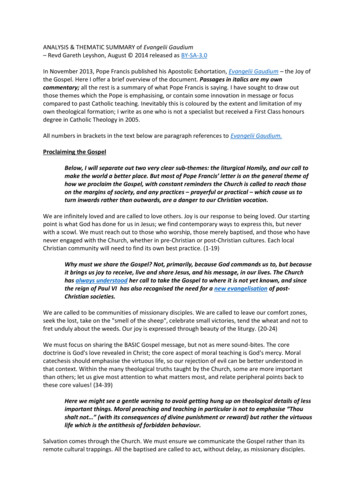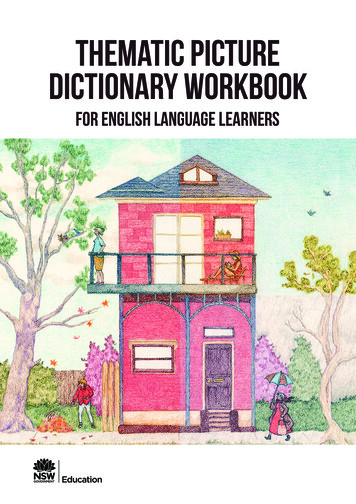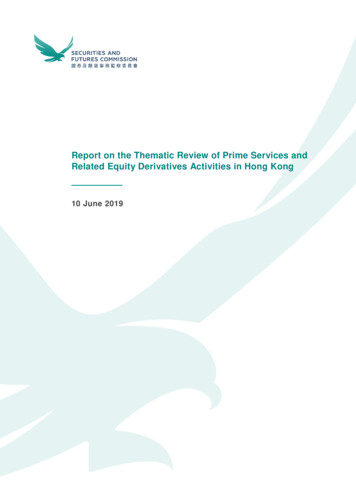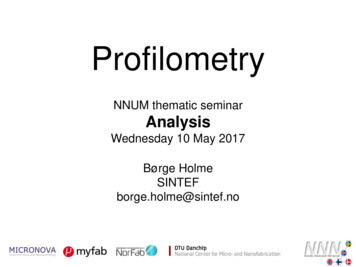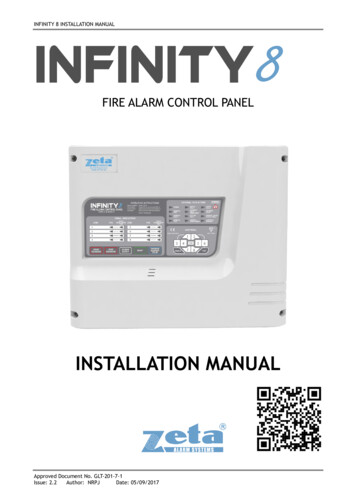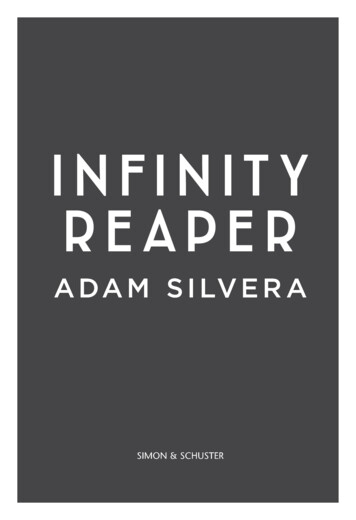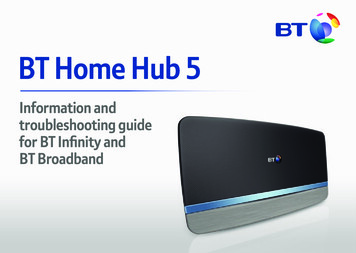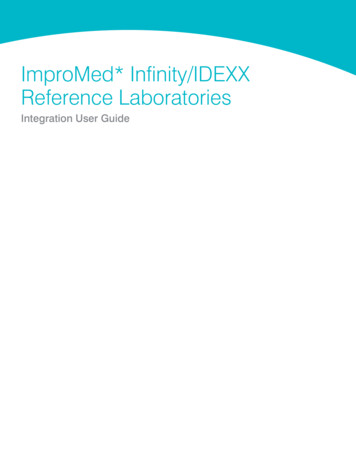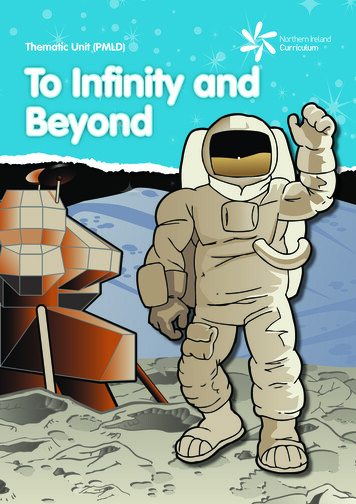
Transcription
Thematic Unit (PMLD)To Infinity andBeyond
OVERVIEWIn this unit learners gain an awareness of outer spaceand space travel. This awareness is developed andembedded through a range of carefully planned andpersonalised sensory experiences such as poetry,stories, songs, ICT, art and music. These activities aresuggestions only. You can adapt or extend them to suityour learners’ age, cognitive ability and specific needs.Please note: before beginning an activity, check that all the resourcesare suitable for your individual learners. For example, some essentialoils may not be appropriate for young children and others may havecontraindications for learners with complex medical needs,life-threatening conditions and/or epilepsy. It is advisable to consulta trained therapist before using essential oils.
ContentsLearning Activity 1Outer SpaceA sensory introduction to space . 2Learning Activity 2RocketsAll about rockets. 6Learning Activity 3Let’s Get Ready to Rumble!A musical story . 10Learning Activity 4Voyage to Outer SpaceA sensory story . 12Learning Activity 5Fun on the MoonMessy and sensory exploration . 14Learning Activity 6Explosion in Outer SpaceInteractive sensory boxes . 20Learning Activity 7Final DestinationMusical body awareness . 22Resources. 24Acknowledgements. 33To Infinity and Beyond1
Learning Activity 1Outer SpaceSetting the SceneWhat to DoOuter space is something most of us will never reallyexperience. However, we can recreate it in our classrooms.It’s all about stimulating the senses through a wide rangeof experiences related to this theme.Introduce your learners to the activity by explaining thatthey are going to learn all about space. Place a silveremergency blanket over them or encourage them to weara pair of moon boots.Decorate your classroom with resources fromwww.twinkl.co.uk (use the word ‘space’ to search) orideas from www.pinterest.com (use the words ‘outerspace – sensory’ to search) or transform your classroominto the NASA space station. Add spaceship portholes toyour classroom windows and use your learners’ artwork totransform your classroom door into a rocket. This will helpto create an atmosphere from the moment your learnersarrive at their classroom.To set the scene, darken the room and play a piece ofcosmic music (downloaded from Audio Networks). Ifpossible, move the learners around the room as you talkabout the sky at night, darkness, twinkling stars, meteorshowers, the moon and the planets.Slowly introduce one experience at a time.If possible, connect twinkling fairy lights to a switch. Forbattery-operated lights, you will need a battery switchadaptor and a switch. For mains-operated lights, you willneed a PowerLink and a switch. You can find these atwww.inclusive.co.uk. Give your learners opportunities toswitch the lights on and off. Encourage them to examinethe lights from different angles. You may wish to singTwinkle, Twinkle Little Star, depending on the age of yourlearners.Introduce your learners to a meteor shower in outer spaceby using an app such as Visual Effects. Depending on thenumber of tablets you have, encourage each learner touse this interactive app to experience cause and effect.Encourage staff to use words like ‘whoosh’, ‘whee’ and‘crash’ as they talk to your learners. If you are still playingspace music in the classroom, simply mute the tabletbefore starting the app.To increase the effectiveness of the app, display it on aninteractive whiteboard (either wirelessly or with a cable) oruse a projector to project it onto an umbrella or net laundrybasket. This activity will allow each learner to experiencethe meteor shower at close proximity and, if appropriate,reach out to explore it from different angles.2To Infinity and Beyond
Areas of LearningPrimaryLanguage and LiteracyThe World Around UsPost-PrimaryEnglishEnvironment and SocietyScience and TechnologyCross-Curricular SkillUsing ICTWhat You Need Silver emergency blanket (to place overyour learners’ legs or wrap around theirshoulders) Moon boots (wellington boots covered infoil) White fairy lights (stars) Data projector attached to a laptop andaccess to the internet Interactive whiteboard Tablet Cat toy on a stick or something similar,with the handle covered in black crêpepaper and tinsel and metallic streamersattached to the string and end to makeit look like a meteor. If possible, attach aglow-in-the-dark or light-up toy to the end Mini silver scourers Access to Audio Networks through C2k tosearch for and download a track calledMeteor Large cardboard moon painted grey withegg cartons stuck to it to resemble craters Long roll of bubble wrap Large cut-out or 3D stars and planets tohang from the ceiling in the centre of thegroup. Before starting this topic, you caninvolve your learners in covering largepaper lampshades or balloons in papiermâché to make planets. Instructions for making a solar systemmobile: search for ‘solar system model’ atwww.enchantedlearning.comTo create an atmosphere in the classroom, play thedownloaded track called Meteor. Sweep the meteor stick(cat toy on a stick) around the room, using big exaggeratedmovements. Make lots of whooshing sounds as youengage with your learners. Hold the stick close to yourlearners and then move it away, to visually stimulate themand encourage tracking. Drop mini silver scourers from aheight or throw them from one learner to another to buildand develop the skill of anticipation.To Infinity and Beyond3
Learning Activity 1 (continued)Outer SpaceFinally, it’s time to explore the planets. Lay some bubblewrap out on the floor and encourage each learner to moveover it, either on foot or in a chair. What can they hear? Isthat the sound of the moon? As one learner does this, passthe cardboard moon around the group, allowing time foreach learner to feel it, look at it and listen to a member ofstaff describe the experience, for example ‘the moon isbumpy’, ‘the moon is big’, ‘the moon is grey’ or ‘the moonis cold’.Use a torch to focus each learner’s attention on one planetat a time. Use individual sensory experiences to representeach planet as you talk about it: Mercury is very cold – pass an ice pack around yourlearners, letting them feel it. Venus is hot and covered by clouds of water vapour –spray your learners lightly with warm water. Mars is known as the red planet – give your learners ared fur fabric circle to explore.4To Infinity and Beyond Jupiter spins very fast and makes lots of differentweather in the clouds – let your learners feel somecotton wool or wadding. Saturn spins very fast and this creates hurricane-likestorms – use a fan with streamers attached to createa wind effect. If available, attach an electric fan to thePowerLink and give each learner the experience ofturning the storm on and off. Uranus is a blue-green colour. Encourage your learnersto explore a circular card painted blue-green or a blueand green jelly. Neptune is named after the Roman god of the sea –give your learners a bowl with blue water (soak a smallamount of blue crêpe paper in water to give it a bluecolour) to investigate. Pluto is very small – pass around a small, light grey orsilver ball that fits into your learners’ hands.
Through your learners’ responses, you will be able toassess which stimuli they react to best. This may beuseful for planning future lessons. It is not essential touse all the sensory experiences every time you have alesson. However, it is important to repeat activities sothat your learners can embed the key concepts.Remember to take photographs of the differentexperiences and learner reactions. These will be usefulfor class discussions and for creating a sensory book inone of the other activities.Further SuggestionsAmazing appsGo to http://amazingspacejourney.com and explorethis app. For some learners this will provide anaugmented reality (AR) experience. You will need todownload and print the augmented reality board fromthe website.Download the Amazing Space Journey 3D Solar Systemapp. You may wish to use the Space Journey app withsome of your older learners. Project it onto a wall, ceiling,whiteboard or white tent (with learners and staff inside)as you talk about the planets and allow them experiencethe individual sensory activities described.Search online for other apps or resources that might helpyou to create a solar system in your room.To Infinity and Beyond5
Learning Activity 2RocketsSetting the SceneLet’s Make A Rocket!Explain to your learners that they are going to learn aboutrockets. Show them different types of rockets from books,posters, toy or model rockets or images on a tablet. You mayeven want to add some junk materials to a younger learner’schair to turn it into a rocket.Experience 1 (Cardboard Rockets)What to DoSearch online for ‘rockets videos for kids’ and apps aboutrockets. In Pathé News on C2k you will find lots of videos ofthe first journeys into space. Some of these have sound andsome do not, but many will provide a suitable stimulus foryour learners.Gather your learners into an area where they can see arange of rockets (models, pictures or on screen). Encouragethem to look, feel and experience the rockets. As theyexamine the rockets, talk about the different parts such asthe windows, the door, the rocket boosters, the fuel tank andthe orbiter. (There are two rocket boosters to lift the shuttle offthe ground and blast it into space. The tank on the outsideof the shuttle holds the fuel for the boosters to launch therocket. Orbiters carry the passengers, astronauts and theirsupplies.)Introduce the children to the song We Love Rockets and thenfinish with the song again. Give your learners a range of brightly coloured or metallicpaints. If appropriate, allow them to choose a colourfrom the range of two or three, to develop choice anddecision-making. Talk to your learners about the coloursand the choices available. Support each learner to choose a cardboard tube to useas a rocket. Encourage them to explore the tube, by:––––––––––––feeling it on different body parts;looking through it;listening to someone talk through it;making a sound into it;listening to you talking about the shape; andlistening to the countdown through it. Encourage your learners (with assistance, if required) toshow their preference for an item to use to paint theirrocket, for example a sponge, paintbrush or glove.Ensure that each learner has enough time to show andcommunicate a preference. Repeat this simple choosingactivity with your learners frequently to reinforce anddevelop their skills. Support each learner to paint a rocket, a cone-shapedtopper and two rocket boosters (small tubes) withassistance as required. When these items are dry, help each learner to add thecone shape to the top of the rocket and the boosters tothe bottom. Talk about the flames that come out of the boosters andhow brightly coloured they are. Allow your learners tofeel and explore a mixture of red, yellow and gold crêpepaper or tissue paper. Encourage and support them totear the paper into strips. Next, add these to the boosters and encourage yourlearners to look at and feel them. Add some round windows to the rocket and let yourlearners admire their work.6To Infinity and Beyond
Areas of LearningPrimaryThe Arts (Music and Art and Design)Language and LiteracyPersonal Development and MutualUnderstandingMathematics and NumeracyPost-PrimaryThe Arts (Music and Art and Design)EnglishMathematicsPersonal DevelopmentWhat You NeedResource 1:We Love Rockets Photos, images, 3D rockets Tablet/Computer (to showimages/video) Small and large cardboardboxes Cardboard tubes Card circles (to make a coneshaped topper for the rocket) Red, yellow and gold crêpe ortissue paper Tin foil Empty plastic bottles Tonic water and ultravioletlight Glow-in-the-dark stars andmoons Glow-in-the-dark paint Poster paints and metallicpaints Glitter, sequins and PVA glue Sponge, paintbrush or glove(to paint with) Rocket signs fromwww.twinkl.co.uk Access to Pathé Newsthrough C2kTo Infinity and Beyond7
Learning Activity 2 (continued)RocketsExperience 2 (Water Rockets)Further Suggestions Support each learner to make their own rocket. You willneed:Rockets in space–– Empty clear plastic water bottle–– Tonic water or water (if using tonic water, you willneed to use an ultraviolet light to make it glow)Range of items for your learners to choose from, forexample:–– glitter–– sequins–– glow-in-the-dark bracelets–– stars and moons–– glow-in-the-dark paint Explain to your learners that they are going to makewater rockets. Before they begin, allow each learner totouch, feel, look at and experience the materials theywill be using. Ask them questions about the experience:What does the glitter feel like? How does the paint feel?Are the bottles light? What does the water feel like? Give your learners a choice of what to put into their waterrocket. Support your learners to place their chosen itemsinto the bottle and half fill it with water or tonic water. Thebracelets will glow in the dark; the tonic water will glowif you use a small ultraviolet light. Tighten the lid on thebottle (and tape if necessary). You could ask each learnerto add some windows and flames to finish the rocket. Encourage your learners to explore their rockets. Whathappens when they roll it? Can they l
Musical body awareness . 22 Resources. 24 Acknowledgements. 33 To Infinity and Beyond 1. Learning Activity 1 Outer Space Setting the Scene Outer space is something most of us will never really experience. However, we can recreate it in our classrooms.

